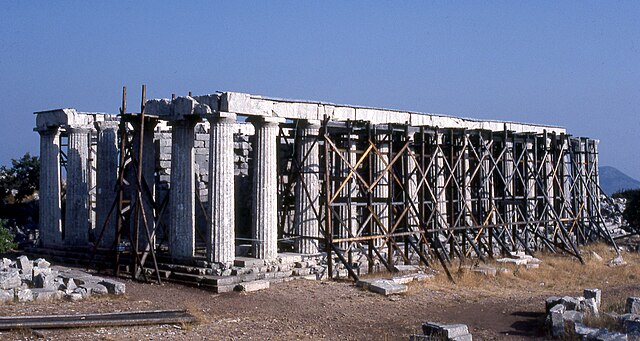The Bassae Frieze is the high relief marble sculpture in 23 panels, 31 m long by 0.63 m high, made to decorate the interior of the cella of the Temple of Apollo Epikourios at Bassae. It was discovered in 1811 by Carl Haller and Charles Cockerell, and excavated the following year by an expedition of the Society of Travellers led by Haller and Otto von Stackelberg. This team cleared the temple site in an endeavour to recover the sculpture, and in the process revealed it was part of the larger sculptural programme of the temple including the metopes of an external Doric frieze and an over-life-size statue. The find spots of the internal Ionic frieze blocks were not recorded by the early archaeologists, so work on recreating the sequence of the frieze has been based on the internal evidence of the surviving slabs and this has been the subject of controversy.
The Bassae Frieze in the British Museum
Reconstruction of the temple showing the frieze in situ, note the Corinthian column, a.
Charles Cockerell's fanciful reconstruction of the temple; there is no evidence for a barrel roof or skylight.
Image: Bassar Frieze 1077
Bassae is an archaeological site in Oichalia, a municipality in the northeastern part of Messenia, Greece. In classical antiquity, it was part of Arcadia. Bassae lies near the village of Skliros, northeast of Figaleia, south of Andritsaina and west of Megalopolis. It is famous for the well-preserved mid- to late-5th century BC Temple of Apollo Epicurius.
View of the temple in 1982
Fragment of a metope, depicting an Amazon, displayed at the British Museum
The Bassae Frieze has its own room at the British Museum.
Foot fragment of a colossal statue at Bassae, displayed at the British Museum








